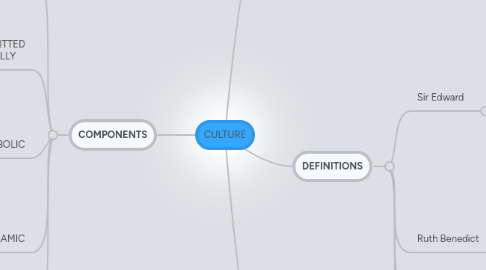
1. COMPONENTS
1.1. CULTURE IS LEARNED
1.1.1. Interactions
1.1.2. Observations
1.1.3. Imitation
1.1.4. E.g. A child acts as his parents
1.2. CULTURE IS TRANSMITTED INTERGENERATIONALLY
1.2.1. Culture is the link to the past and through future generations
1.2.1.1. Way to act
1.2.1.2. What to say
1.3. CULTURE IS SYMBOLIC
1.3.1. Symbol-making
1.3.1.1. Transmission
1.3.1.2. Share Information
1.3.1.3. Create History
1.3.1.4. Preserve
1.4. CULTURE IS DYNAMIC
1.4.1. Innovation
1.4.2. New ideas
1.5. CULTURE IS ETHNOCENTRIC
1.5.1. Sense of superiority
1.5.2. Lack of contact with other cultures
1.5.3. Innhability to understand and accept differences
2. LINK TO FIELDS
2.1. Corporate Management
2.2. Health care
2.3. Psychology
2.4. Educaction
2.5. Public Relations
2.6. Marketing
2.7. Advertising
3. DEFINITIONS
3.1. Sir Edward
3.1.1. Complex whole
3.1.1.1. Knowledge
3.1.1.2. Belief
3.1.1.3. Art
3.1.1.4. Morals
3.1.1.5. Law
3.1.1.6. Custom
3.1.1.7. Habits
3.2. Ruth Benedict
3.2.1. What binds men together
3.2.2. Ideas / standards in common
3.3. Clifford Geertz
3.4. Gudy Kunst
3.4.1. Culture is the rules in a society to live and function
4. Provide
4.1. A framework that give meaning to events, objects,...
4.1.1. Trasnsmited Pattern
4.1.1.1. Symbols
4.1.1.1.1. Communicate
4.1.1.1.2. Develop
4.1.1.1.3. Perpetuate
